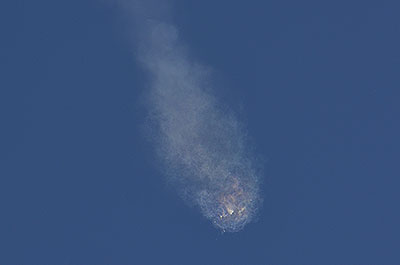On June 28, 2015, following a nominal liftoff, Falcon 9 experienced an overpressure event in the upper stage liquid oxygen tank approximately 139 seconds into flight, resulting in loss of mission. This summary represents an initial assessment, but further investigation may reveal more over time.
Prior to the mishap, the first stage of the vehicle, including all nine Merlin 1D engines, operated nominally; the first stage actually continued to power through the overpressure event on the second stage for several seconds following the mishap. In addition, the Dragon spacecraft not only survived the second stage event, but also continued to communicate until the vehicle dropped below the horizon and out of range.
SpaceX has led the investigation efforts with oversight from the FAA and participation from NASA and the U.S. Air Force. Review of the flight data proved challenging both because of the volume of data — over 3,000 telemetry channels as well as video and physical debris — and because the key events happened very quickly.
From the first indication of an issue to loss of all telemetry was just 0.893 seconds. Over the last few weeks, engineering teams have spent thousands of hours going through the painstaking process of matching up data across rocket systems down to the millisecond to understand that final 0.893 seconds prior to loss of telemetry.
At this time, the investigation remains ongoing, as SpaceX and the investigation team continue analyzing significant amounts of data and conducting additional testing that must be completed in order to fully validate these conclusions. However, given the currently available data, we believe we have identified a potential cause.
Preliminary analysis suggests the overpressure event in the upper stage liquid oxygen tank was initiated by a flawed piece of support hardware (a "strut") inside the second stage. Several hundred struts fly on every Falcon 9 vehicle, with a cumulative flight history of several thousand. The strut that we believe failed was designed and material certified to handle 10,000 lbs of force, but failed at 2,000 lbs, a five-fold difference. Detailed close-out photos of stage construction show no visible flaws or damage of any kind.
In the case of the CRS-7 mission, it appears that one of these supporting pieces inside the second stage failed approximately 138 seconds into flight. The pressurization system itself was performing nominally, but with the failure of this strut, the helium system integrity was breached. This caused a high pressure event inside the second stage within less than one second and the stage was no longer able to maintain its structural integrity.
Despite the fact that these struts have been used on all previous Falcon 9 flights and are certified to withstand well beyond the expected loads during flight, SpaceX will no longer use these particular struts for flight applications. In addition, SpaceX will implement additional hardware quality audits throughout the vehicle to further ensure all parts received perform as expected per their certification documentation.
As noted above, these conclusions are preliminary. Our investigation is ongoing until we exonerate all other aspects of the vehicle, but at this time, we expect to return to flight this fall and fly all the customers we intended to fly in 2015 by end of year.
While the CRS-7 loss is regrettable, this review process invariably will, in the end, yield a safer and more reliable launch vehicle for all of our customers, including NASA, the United States Air Force, and commercial purchasers of launch services. Critically, the vehicle will be even safer as we begin to carry U.S. astronauts to the International Space Station in 2017.













